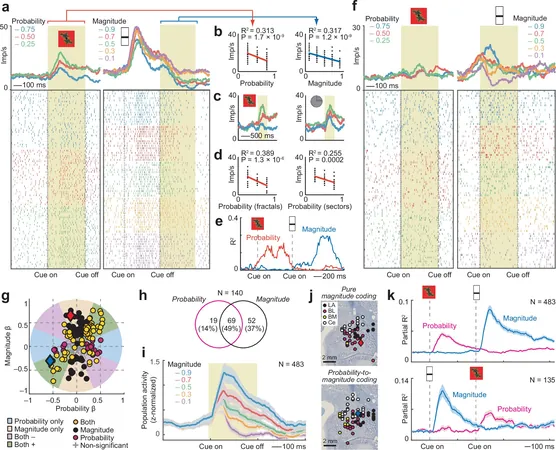
Stunning Discovery: Ancient Galaxy Found by James Webb Telescope Challenges Our Understanding of the Universe's Origins!
2025-03-28
Author: Wei
In an astonishing revelation, the James Webb Space Telescope (JWST) has unveiled a remarkable ancient galaxy that is providing unprecedented insights into the nascent stages of our universe. This discovery showcases a brilliant beacon of ultraviolet (UV) light emanating from a distant galaxy, fundamentally shifting our comprehension of the early universe.
Published in the esteemed journal Nature on March 26, this groundbreaking study suggests that the universe's first stars may have influenced their cosmic surroundings much earlier than scientific models had previously predicted.
In the aftermath of the Big Bang, the universe was an amalgam of protons, neutrons, and electrons. As it began to cool, these protons and neutrons united to create positively charged hydrogen ions, which subsequently attracted negatively charged electrons, forming a dense fog of neutral hydrogen atoms. This primordial fog was notorious for absorbing short-wavelength light, particularly UV light, thereby obscuring it from reaching vast distances in the universe.
However, the emergence of the first stars and galaxies heralded a turning point. These entities unleashed a torrent of UV light, which was powerful enough to strip electrons from hydrogen atoms, thereby clearing the fog and allowing light to travel freely once again. Although the transition known as the "Era of Reionization" is believed to have wrapped up roughly one billion years post-Big Bang, the precise timeline regarding the formation of early stars and the onset of this era remains a subject of intense investigation.
The latest findings indicate a significant leap in understanding this timeline. JWST's observations focused on an ancient galaxy designated JADES-GS-z13-1, located so far from Earth that we are witnessing it as it appeared just 330 million years after the Big Bang—a cosmic blink of an eye in the grand scheme.
The researchers detected a distinctive bright light at a wavelength known as Lyman-alpha emission, a feature linked to hydrogen. Although this light originated in the ultraviolet spectrum, the universe's expansive growth over the past 13 billion years has stretched it into the infrared region, making it detectable by the sophisticated instruments of JWST.
For this Lyman-alpha emission to reach Earth in its current state, the galaxy JADES-GS-z13-1 must have ionized a substantial amount of its surrounding hydrogen gas, an occurrence scientists did not expect to happen so soon in the universe's timeline.
Roberto Maiolino, a co-author of the study and an astrophysicist at the University of Cambridge, expressed excitement, stating, "GS-z13-1 is observed when the universe was just 330 million years old, yet it shows a surprisingly clear signature of Lyman-alpha emission, indicating that the surrounding fog has been significantly lifted. This groundbreaking result contradicts existing theories of early galaxy formation and has taken astronomers by surprise."
The ramifications of this discovery are profound. Researchers are still trying to ascertain whether the Lyman-alpha radiation from JADES-GS-z13-1 is the product of exceptionally hot and massive early stars or if it is linked to an early supermassive black hole.
Kevin Hainline, an astronomer at the University of Arizona and co-author of the study, remarked, "We really shouldn't have found a galaxy like this, given our understanding of the way the universe has evolved. It's as if we envisioned the early universe shrouded in a thick fog, complicating our ability to identify even the most powerful cosmic beacons. Yet, here we are, observing this galaxy's light piercing through the darkness."
This captivating emission line offers vital clues that could reshape our understanding of when and how the universe transitioned into its current state, urging us to revisit the frameworks of early cosmic evolution.
Stay tuned as researchers delve deeper into the mysteries of JADES-GS-z13-1, unlocking secrets that continue to challenge our understanding of the cosmos.


 Brasil (PT)
Brasil (PT)
 Canada (EN)
Canada (EN)
 Chile (ES)
Chile (ES)
 Česko (CS)
Česko (CS)
 대한민국 (KO)
대한민국 (KO)
 España (ES)
España (ES)
 France (FR)
France (FR)
 Hong Kong (EN)
Hong Kong (EN)
 Italia (IT)
Italia (IT)
 日本 (JA)
日本 (JA)
 Magyarország (HU)
Magyarország (HU)
 Norge (NO)
Norge (NO)
 Polska (PL)
Polska (PL)
 Schweiz (DE)
Schweiz (DE)
 Singapore (EN)
Singapore (EN)
 Sverige (SV)
Sverige (SV)
 Suomi (FI)
Suomi (FI)
 Türkiye (TR)
Türkiye (TR)
 الإمارات العربية المتحدة (AR)
الإمارات العربية المتحدة (AR)